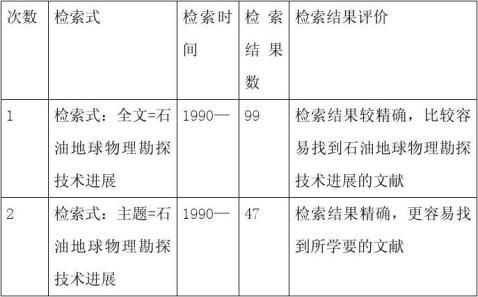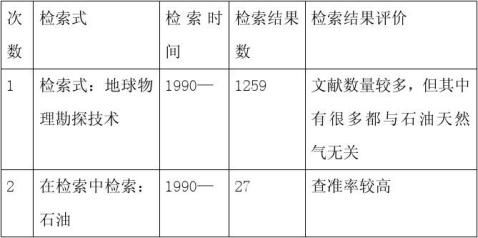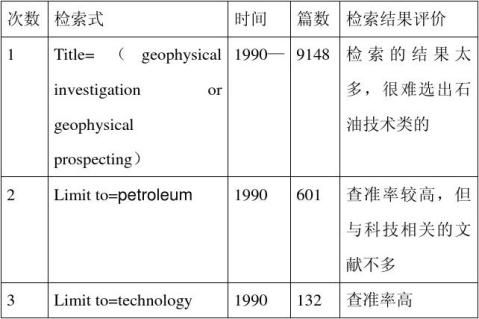《信息检索与网络资源利用》
检 索
课题名称:
专业班级:
学 号:
姓 名:邢廷栋
完成日期: 报 告
石油地球物理勘探技术进展
一.检索报告概况
1.课题名称:石油地球物理勘探技术进展
2.涉及的学科及中图分类号:工程科技>石油天然气工业>石油勘探与开采
中图分类号:P631.4
3.检索时间范围、地域范围及文献类型:1990至今; 地域范围:国内与国外
文献类型:期刊,会议论文,学术论文,学位论文。
4.反映课题内容的检索词及扩展词:
中文检索词:石油,天然气,地球物理勘探,物探,技术,科技,进展,进度,
英文检索词: petroleum;oil; geophysical investigation;
geophysical prospecting;Geophysics; technique;technology;evolve; develop.
5.简要的课题内容分析:
通过查阅文献,将对进年来地球物理勘探技术在石油行业中的发展进度以及了解一些新的石油地球物理勘探方法与技术。
二.检索过程
三.1. 选择检索工具或检索系统
CNKI—中国期刊全文数据库;万方数据;中国石油文献数据库;EI village
2、实施检索及筛选检索结果 例如:
2.1 CNKI—中国期刊全文数据库
(1)检索过程

(3)从检索结果中找到代表性文献 20 篇,列出最相关的3篇(作者、题名、出处、文摘)。
[1]张玮,詹仕凡,张少华,李培明,王克斌,冯许魁,何展翔.石油地球物理勘探技术进展与发展方向[J].中国工程科学,2010,05:97-101+112.【摘要】 石油地球物理勘探技术仍面临巨大的挑战,面向复杂地表、面向多类型地质目标、面向油气田
开发提高采收率的地球物理技术正成为未来的发展方向。面对复杂地质条件和高精度要求,理清需要我们突破的关键技术十分重要,同时也是地球物理服务公司实现产业转型,增强国际竞争能力的现实需求。
[2]张军华.凝集最新科研成果,推动石油地球物理勘探发展——20xx年《石油地球物理勘探》评述[J].石油地球物理勘探,2010,05:778-789+792+624.【摘要】 本文系统介绍了五年来中国石油集团在高陡构造、碳酸盐岩、低渗透油气藏和火山岩等复杂勘探对象技术攻关中所取得的成果和认识,分析了在攻关中创新集成并推广应用的一系列地球物理新技术,如高密度、全数字、拓频处理、新老资料融合处理、叠前深度偏移成像、叠前储层预测、烃类检测、碳酸盐岩缝洞精细雕刻及多波地震等技术在实际生产中的应用效果、技术适用性和下步发展方向。同时通过系统分析中国石油集团未来油气勘探开发对地球物理技术的需求,提出了发展油气勘探地球物理、油藏地球物理、天然气地球物理三大技术系列的任务和发展思路,展示了地球物理技术应用的广阔前景。
[3]程金箴,李光文.我国石油地球物理勘探技术现状与展望[J].石油地球物理勘探,1990,01:1-9+126.【摘要】 《石油地球物理勘探》是我国石油勘探类最重要的杂志之一。20xx年除获得"北方十佳期刊奖"外,还获"新中国60年有影响力的期刊奖"。本年度共发表各类文章134篇,内容涉及8个方面:正演模拟技术、地震采集方法
与技术、地震处理方法与技术、地震综合解释与油气预测、重磁电勘探方法与技术、测井技术与应用、计算机软件开发与应用、综述与论坛。评述认为,本刊研究内容全面、学术含量高、杂志印刷精美,论文及时凝集了石油地球物理勘探的最新科技发展成果,促进了物探技术的全面提高。年度文章中,波动方程数值模拟具有较高的理论价值,特殊地质体的描述方法很有特色、具有较高的应用价值。建议刊物今后应注重作者论文中间分析过程的给出,鼓励发表一些小、巧、特的短篇幅论文。
2.2 万方数据库

(2)从检索结果中找到代表性文献 17 篇,列出最相关的3篇(作者、题名、出处、文摘)。
[1]周涛.浅谈油气地球物理勘探技术进展[J].中国科技纵横,2011,(14):280.【摘要】石油、天然气是现在全世界主要的能量资源,这两种资源对于我们人类来说是必不可少的重要能量资源.
随着现在技术的发展石油,天然气地球物理勘探技术也在不断的进步.本文主要探讨我国石油,天然气地球物理勘探技术的进展.
[2]张向林,陶果,刘新茹等.油气地球物理勘探技术进展[J].地球物理学进展,2006,21(1):143-151.【摘要】文章回顾了中国油气测井、物探的发展历程,分析了中国油气地球物理勘探方法研究、装备、处理解释技术的现状及在世界油气勘探中的地位,分别从测井技术的方法、井下仪器、地面系统及资料处理解释评价方面和地震勘探的方法、震源、检波器、地面系统及资料处理解释方面介绍了中国油气地球物理勘探技术的发展及方向.
[3]军,郝会民,李国旗等.物探装备技术进展与发展方向[J].中国工程科学,2010,12(5):78-83.【摘要】中国石油工业的掘起与腾飞,使物探装备技术得到了快速发展.地震勘探仪器经历了6次升级换代,契而不舍地追踪国外先进技术,保持了与时俱进、同步发展的局面;可控震源技术走"引进、吸收、消化、创新"的道路,经过20多年的艰辛研发,达到领先或局部领先国际的技术水平;地震辅助装备坚持"自力更生、自主开发"方针,经历30多年探索与创新,使国产设备闪亮挤身于国际勘探市场.自主开发的辅助装备,也取得了长足的进步.
%0
2.3 中国石油文献数据库


(3)从检索结果中找到代表性文献 32 篇,列出最相关的3篇(作者、题名、出处、文摘)。
(1)邓勇,李添才,南海西部海域油气地球物理勘探中地震处理技术新进展【J】天然气地球科学,2011,22(1):45-65【摘要】南海西部海域具有广阔的油气勘探前景。该区经历了从浅海陆架到深海海域,由浅层到中深层的多层次、多领域、多区带及目标的油气勘探活动。近几年随着加大中深层勘探及研究的力度,在地球物理勘探及地震资料采集与处理技术方面均取得了新的进展和突破。根据南海西部海域不同盆地油气地质特点及所表征的地球物理信息(主要为地震反射特征),提出因地制宜,在用好传统地震资料处理技术和方法的同时,针对地质条件复杂的勘探新领域中的新问题,不断创新地震数据处理技术及方法,逐步完善配套一系列成熟的地震处理技术,为开创南海北部油气勘探新局面、建立“海上大庆”提供技术支撑和技术保障。
(2)云美厚,汇聚科技创新篇章,引领石油物探方向——20xx年《石油地球物理勘探》评述,石油地球物理勘探,2011,46(5):76-86【摘要】20xx年,《石油地球物理勘探》杂志保持了原有的办刊特色,并在充实内容、扩大信息量方面做了较大
改进。全年累计发表论文153篇,论文数量较往年有了大幅度增长。主要内容大致概括为九个方面:1.地震正演模拟;2.地震采集技术;3.地震数据处理方法技术;4.地震综合解释与储层预测;
5.油气检测与四维地震;6.天然气水合物勘探;7.测井技术应用;
8.重磁电勘探方法技术;9.软件开发与应用及综述。总之,登载论文全面展现了石油物探(及相关)领域技术的最新进展和研究成果,客观反映了我国石油地球物理勘探(及相关)行业的科研水平、技术创新和实际应用能力,引领了我国石油物探的发展方向。同时也给该刊提出了几点建议。
(3)滕吉文,石油地球物理勘探的发展空间与自主创新,石油物探,2007,46(3):12-19【摘要】研究和探讨了石油地球物理的发展空间和深化研究的导向:即必须认识当今世界和中国对矿产资源的需求以及中国对国外石油资源的依存度,建立安全、稳定、可靠和能持续供给的能源战略后备基地。中国石油地球物理勘探向第二深度空间(5000~10000m)、向复杂与勘探困难的地质构造地区、岩相地层区,特别是海相地层地带发展乃是石油地球物理勘探与开发的战略目标,进行构造与油气、岩性地层与油气、火山岩体与油气、海相和陆相及交混相与油气、有机和无机与油气等油气生成和赋存形式的有机综合研究,并在当代相邻学科高新技术成果的有效应用和不断深化认识的基点上,强化高层次的综合研究与集成。
2.4 EI village

(4)从检索结果中找到代表性文献 63 篇,列出最相关的3篇(作者、题名、出处、文摘)。
[1]. Aydemir, A., An Integrated Geophysical Investigation of Haymana Basin and Hydrocarbon Prospective Kirkkavak Formation in Central Anatolia, Turkey. Petroleum Geoscience, 2011. 17(1): p. 91-100.
Abstract:
In this study, all available geological, geophysical and geochemical data were integrated to assess the hydrocarbon prospectivity of the Haymana Basin, an interior basin in Central Anatolia. First, the basin was modelled in three dimensions (3D) using gravity data which identified the deepest part of the basin to the east of Haymana, south of Ankara. This potential
hydrocarbon generation area has not been properly explored. Next, the first order vertical derivative of the gravity anomaly map was computed to identify boundaries of prospective structures from inflections in the gravity gradient. Aeromagnetic data were transformed to an analytical signal to identify the probable locations of buried magmatic intrusions. The prospective part of the Haymana Basin was interpreted as being located to the east of an intrusion. Finally, all available geochemical data of the Kirkkavak Formation were classified for different parameters (TOC, S1+S2 and Tmax) and maximum values of each parameter were mapped. In comparing the 3D depth model with individual geochemical maps, it was observed that each geochemical parameter was consistent with the interpreted prospective zone of the Haymana Basin. 2011 EAGE/Geological Society of London.
[2]. Yakymchuk, N.A., S.P. Levashov and I.N. Korchagin. Express-Technology for direct searching and prospecting of hydrocarbon accumulation by geoelectric methods. in International Petroleum Technology Conference, IPTC 2008, December 3, 2008 - December 5, 2008. 2008. Kuala Lumpur, Malaysia: Society of Petroleum Engineers.
Abstract:
The late publications testify that now the scientific institutions and service companies give the important attention to geoelectric and electromagnetic methods (EM) of prospecting and exploring of oil and gas fields. New EM methods are actively developed and the known ones are improved, the more wider application of these methods is observed during investigation for oil and gas, both onshore, and offshore, and the aspiration of the companies to purposeful integration of EM methods with seismic is marked also. There is the impression that the breakthrough technology for effective prospecting and exploring of hydrocarbon (HC) deposits can be created in the near future if not on the base of geoelectric methods only, but it is obligatory with their participation. In this paper the authors generalize the results of experimental application in 2001-2008 of some geoelectric methods for the oil and gas accumulations prospecting and exploring. These methods can form the effective geoelectric express-technology of "direct" prospecting for hydrocarbon. The express-technology includes the methods of forming of short-pulsed electromagnetic field (FSPEF) and vertical electric-resonance sounding (VERS),
compact and computerized equipment for field observations, software for measurement data registrations, processing and interpretation (FSPEF-VERS technology). These methods are based on studying the geoelectric parameter of the medium in the pulsed, not installed geoelectric fields, as well as the quasi-stationary electric field of the Earth and its spectral features over HC accumulations. An integrated application of these methods allow to find and map on the area the "deposit" type anomalies (DTA), to value the total thickness of anomalous polarized layer (APL) of the "oil", "gas", "water" type and etc, and to define their bedding depths. The realized possibility of conducting the areal surveys from moving car and airplane allows to examine the vast territory operatively. The technology has had broad approbation on hydrocarbon deposits and perspective area in Ukraine, Republic of Kazakhstan and Russia during 2001-2008. Geoelectric investigations were conducted on 50 oil and gas fields. The "deposit" type anomalies were fixed by FSPEF survey on all (50!) fields. APL of "oil-and-gas layer" type was chosen by VERS sounding in cross-sections of all this oilfields. Geoelectric "deposit" type anomalies were also mapped by FSPEF survey within 50 perspectives for oil and gas structures and separate
areas from 62 investigated. The main distinctive feature of FSPEF-VERS methods consist in that they are based exclusively on non-classical principles of EM soundings. They are focused initially on structure studying of a near-surface layer of the charged particles, of polarization zones on borders of geological heterogeneities of a cross-section and of natural electromagnetic radiation of the Earth. Such non-classical approach has allowed creating: the compact small-sized measuring equipment, easy for transportation and convenient in service; an effective technique of operative carrying out the field measurements; the unique technology of the solving of a wide class of ecological, engineering-geological, hydro-geological and geologic-geophysical problems. The general purpose of this paper is to attract attention of specialist-geoelectricians and geophysicists for the objective necessity of studying the natural electromagnetic radiation of the Earth (zones of polarisation, structure of near-surface layer of the charged particles, etc.) owing to that the further development of this direction promises broad opportunities for creation of effective innovative technologies of geoelectric investigation. Copyright 2008, International Petrolaum Conference.
[3]. Lago, A.L., et al., Geophysical investigation using resistivity and GPR methods: A case study of a lubricant oil waste disposal area in the city of Ribeirao Preto, Sao Paulo, Brazil. Environmental Geology, 2009. 58(2): p. 407-417. Abstract:
Geophysics has been shown to be effective in identifying areas contaminated by waste disposal, contributing to the greater efficiency of soundings programs and the installation of monitoring wells. In the study area, four trenches were constructed with a total volume of about 25,000 m3. They were almost totally filled with re-refined lubricating oil waste for approximately 25 years. No protection liners were used in the bottoms and laterals of the disposal trenches. The purpose of this work is to evaluate the potential of the resistivity and ground penetrating radar (GPR) methods in characterizing the contamination of this lubricant oil waste disposal area in Ribeirao Preto, SP, situated on the geological domain of the basalt spills of the Serra Geral Formation and the sandstones of the Botucatu Formation. Geophysical results were shown in 2D profiles. The geophysical methods used enabled the identification of geophysical anomalies, which characterized
the contamination produced by the trenches filled with lubricant oil waste. Conductive anomalies (smaller than 185 m) immediately below the trenches suggest the action of bacteria in the hydrocarbons, as has been observed in several sites contaminated by hydrocarbons in previously reported cases in the literature. It was also possible to define the geometry of the trenches, as evidenced by the GPR method. Direct sampling (chemical analysis of the soil and the water in the monitoring well) confirmed the contamination. In the soil analysis, low concentrations of several polycyclic aromatic hydrocarbons (PAHs) were found, mainly naphthalene and phenanthrene. In the water samples, an analysis verified contamination of the groundwater by lead (Pb). The geophysical methods used in the investigation provided an excellent tool for environmental characterization in this study of a lubricant oil waste disposal area, and could be applied in the study of similar areas. Springer-Verlag 2008.
三. 通过阅读原文,归纳各家观点,并做简要评述,外文参考文献不做评述。
1.石油地球物理勘探技术所面临的挑战
石油地球物理勘探技术仍面临巨大的挑战,面向复杂地表、面向多类型地质目标、面向油气田开发提高采收率的地球物理技术正成为未来的发展方向,面对复杂地质条件和高精度要求,理清需要我们突破的关键技术十分重要。在这找不到油气田的情况下,都要促使我们向科学技术要油气。
2.石油地球物理勘探的新技术新发展
随着技术与科技的迅速发展,如今的地球物理勘探不知是地震法者一种勘探方式,而是发展起来多种勘探方法及其综合使用,例如重磁勘探技术进展,电法勘探,重磁电综合解释平台等勘探方法,这些技术的兴起与发展给石油物探增加的许多的新元素,如今在油气田难找的情况下,已经不是一种勘探方法所能解决的,而是要应用多种方法共同作用。此外在数据处理技术方面也有较大的发展,解释技术的进步, 无疑在复杂油气勘探开发条 件下发挥了重要作用。随着面向复杂地质体和面向油气开发需要, 地震解释技术的发展主要体现在几个方面:
1)复杂构造的描述和实体模型的建立是构造解释技术发展的重要方向。
2)处理解释一体化的信息分析和现代属性解
释技术是地震解释发展方向。
3)高精度叠前反演(包括多波多分量联合反演、非线性反演、深度域反演、波形反演、基于层序及沉积相控制的反演、地质统计反演等)是岩性及储层预测的主要研究方向。
4)基于勘探开发综合数据库的一体化三维可视化体解释技术。
3.我国综合物探技术发展方向
面向高精度, 三维重磁电勘探技术将成为主流。重磁电三维直到最近才明确提出, 但已经成为重磁电技术发展的一个方向; 对于重磁勘探, 则以高密度高精度数据采集和三维反演为特征, 而电磁勘探则以小面元采集方法、多场源激发和三维正反演为特 征。面向综合, 多种物探方法联合勘探。多方法联合勘探是解决复杂地质问题最有效的手段, 已经成为国际大油公司的共识, 是目前油气地球物理勘探方法发展的一个重要方向。地震方法的短处有时正好是重磁电的长处, 多方法联合勘探综合解释可以发挥不同物探技术间的互补优势。面向开发, 向油气目标检测及开发领域发展。高精度重磁电勘探技术正在向油气检测和开发监测发展; 海洋可控源电磁勘探已经被西方油公司列入海洋勘探程序, 推动了海洋电磁研究与应用; 人工源时频电磁技术检测目标含油气概率也得到国际大油公司的青睐, 井间电磁和地井电磁等方法应用于油田开发寻找剩余油气和监测开发过程。
四. 参考文献(按参考文献的格式编写最终的检索结果)
[1]张玮,詹仕凡,张少华,李培明,王克斌,冯许魁,何展翔.石油地球物理勘探技术进展与发展方向[J].中国工程科学,2010,05:97-101+112.
[2]张军华.凝集最新科研成果,推动石油地球物理勘探发展
——20xx年《石油地球物理勘探》评述[J].石油地球物理勘探,2010,05:778-789+792+624.
[3]程金箴,李光文.我国石油地球物理勘探技术现状与展望[J].石油地球物理勘探,1990,01:1-9+126.
[4]周涛.浅谈油气地球物理勘探技术进展[J].中国科技纵横,2011,(14):280.
[5]张向林,陶果,刘新茹等.油气地球物理勘探技术进展[J].地球物理学进展,2006,21(1):143-151.
[6]滕吉文,石油地球物理勘探的发展空间与自主创新,石油物探,2007,46(3):12-19
五. 检索体会
1.检索过程中要根据所检索的内容选择数据库,这样才能更准确的更全面的查到自己想要的文献。
2.选择不同的数据库要注意其检索方式不同,要灵活应用各种检索方法,
3.检索过程中要注意选择检索式,比如在cnki检索中“主题=石油地球物理勘探技术进展”会有49篇论文,而“关键词=石油地球物理勘探技术进展”会有0篇文章.
4.无论用那个数据库,都要注意主题词的扩展词的检索,否则很容易漏检。
